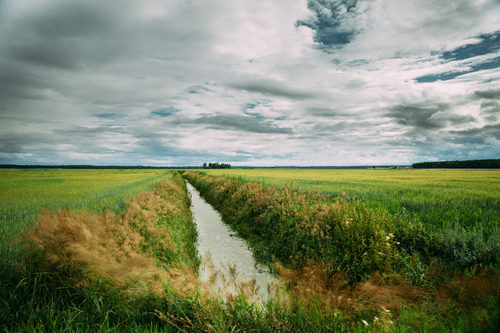Exploring Different Types of Agricultural Drainage Systems

Agricultural drainage is an essential aspect of farming, particularly in areas where the soil is waterlogged or heavy clay. It involves the removal of excess water from fields to improve soil structure and facilitate optimal crop growth. There are several types of agricultural drainage, including surface drainage, subsurface drainage, and vertical drainage.
Surface drainage is the simplest form of agricultural drainage and involves the removal of excess water from the surface of the soil. This can be achieved through the use of channels, ditches, or other types of surface water management systems. Surface drainage is particularly useful in areas with gentle slopes or where the soil has a high water table.
Subsurface drainage involves the installation of pipes or drains below the surface of the soil to remove excess water from the root zone. This type of drainage is suitable for areas with heavy clay soils or where the water table is close to the surface. Subsurface drainage can be installed using various methods, including mole ploughing, trenching, or installing drainage pipes using a drainage plough.
Vertical drainage is a type of agricultural drainage that involves the installation of vertical drains to remove excess water from the soil. This method is typically used in areas with deep or compacted soils, where the water table is deep below the surface. Vertical drainage is achieved by drilling holes into the soil and inserting permeable pipes, gravel, or other porous materials into the ground.
The choice of drainage system depends on a variety of factors, including soil type, topography, and the availability of resources. Some of the key factors to consider when choosing a drainage system include the cost, the effectiveness of the system, and the environmental impact.
Surface drainage is often the most cost-effective option, as it requires minimal infrastructure and maintenance. However, this type of drainage is less effective in areas with steep slopes or heavy rainfall. Subsurface drainage, on the other hand, is more expensive to install but is more effective in removing excess water from the soil.
Vertical drainage is typically the most expensive option, as it requires specialized equipment and materials. However, this type of drainage is particularly effective in areas with deep or compacted soils, where other types of drainage may be less effective.
When choosing a drainage system, it is essential to consider the environmental impact of the system. Agricultural drainage can have a significant impact on the surrounding ecosystem, particularly if the water contains pollutants or excess nutrients. Surface drainage systems can lead to soil erosion and nutrient loss, while subsurface drainage can lead to groundwater contamination.
To minimize the environmental impact of agricultural drainage, it is essential to use best management practices, such as reducing the use of fertilizers and pesticides and minimizing soil erosion. In addition, farmers can use alternative drainage systems, such as constructed wetlands or bioreactors, to treat drainage water before it is released into the environment.
Our agricultural drainage services
At Mantank Environmental Services we have over 25 years of experience in the drainage industry. Our team specialise in working on complex projects where a team of drainage specialists is required.
Our agricultural drainage services ensure that any drainage problems your farming land may be experiencing are resolved as quickly and efficiently as possible. We have depots throughout the UK and cover a wide area, so wherever you are, our team are on hand to assist you.
Speak to our team
If you would like to know more about the services we provide, do not hesitate to get in touch with our team. To speak with us simply fill in our contact form and we will be in touch as soon as possible.
